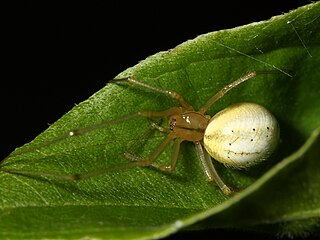
Theridiidae, also known as the tangle-web spiders, cobweb spiders and comb-footed spiders, is a large family of araneomorph spiders first described by Carl Jakob Sundevall in 1833. This diverse, globally distributed family includes over 3,000 species in 124 genera, and is the most common arthropod found in human dwellings throughout the world.

Scaffold web spiders or cave cobweb spiders (Nesticidae) are a family of araneomorph spiders closely allied with tangle-web spiders (Theridiidae). Like the Theridiidae, these spiders have a comb of serrated bristles on the hind tarsi that are used to pull silk bands from the spinnerets. Nesticidae contains 16 genera and about 300 species, many of which are associated with caves or overhangs. The genus Nesticus is the type for the family and is found throughout the world. The related Eidmannella has speciated considerably in Texas caves and includes some extremely localized species that are considered threatened. One species, Eidmannella pallida, is found in caves and under overhangs, but also in agricultural fields and other habitats away from such restricted areas. The genus Carpathonesticus is found in central Eurasia.

The Farquhar Group belong to the Outer Islands of the Seychelles, lying in the southwest of the island nation, more than 700 km (430 mi) southwest of the capital, Victoria, on Mahé Island.

Ochyroceratidae is a six-eyed spider family, with 165 described species in ten genera. They are common inhabitants of caves and the tropical forest litter of South Africa, the Caribbean, Asia and South America. Considered an ecological counterpart of the Linyphiidae of the northern temperate zone, species are especially diverse in the Indo-Pacific region.

Argyrodes, also called dewdrop spiders, is a genus of comb-footed spiders that was first described by Eugène Louis Simon in 1864. They occur worldwide, and are best known for their kleptoparasitism. They can spin their own webs, but tend to invade and reside in their hosts' webs. This relationship can be commensal or even mutual if the dewdrop spider feeds on small trapped insects that are not eaten by the host. Some species can even prey upon the host.
Seychellia is a genus of long-legged cave spiders that was first described by Michael I. Saaristo in 1978.
Andasta is a genus of ray spiders that was first described by Eugène Louis Simon in 1895.
Argyrodella is a monotypic genus of Seychelloise comb-footed spiders containing the single species, Argyrodella pusillus. It was first described by Michael I. Saaristo in 2006, and is found on the Seychelles.
Pleorotus was a monotypic genus of Seychelloise huntsman spiders containing the single species, Pleorotus braueri. It was first described by Eugène Louis Simon in 1898, and was endemic to the Seychelles. The description was based on a single male collected on Mahe Island in 1894, but none have been found in later collections, and it has been declared extinct.
Zoma is a genus of ray spiders that was first described by Michael I. Saaristo in 1996. As of June 2020 it contains three species, found in Japan, China, and on the Seychelles: Z. dibaiyin, Z. fascia, and Z. zoma.
Cenemus is a genus of Seychelloise cellar spiders that was first described by Michael I. Saaristo in 2001. As of June 2019 it contains only three species, found only on the Seychelles: C. culiculus, C. mikehilli, and C. silhouette.
Theoa is a genus of sheet weavers that was first described by Michael I. Saaristo in 1995.
Nanume is a monotypic genus of comb-footed spiders containing the single species, Nanume naneum. It was first described by Michael I. Saaristo in 2006, and is found on the Aldabra Atoll.

Phycosoma is a genus of comb-footed spiders that was first described by Octavius Pickard-Cambridge in 1880.

Rhomphaea is a genus of comb-footed spiders that was first described by Ludwig Carl Christian Koch in 1872.

Seycellesa is a genus of spiders in the family Theridiidae. It consists of only its type species: Seycellesa braueri, which is endangered and endemic to the Seychelles.
Spinembolia is a monotypic genus of African comb-footed spiders containing the single species, Spinembolia clabnum. It was first described by Michael I. Saaristo in 2006, and is found on the Seychelles.
Stoda is a monotypic genus of African comb-footed spiders containing the single species, Stoda libudum. It was first described by Michael I. Saaristo in 2006, and is found on the Seychelles.
Michael I. Saaristo was a Finnish arachnologist, with a particular interest in the spiders of the Seychelles. The World Spider Catalog lists 61 genus names or synonyms and 109 species names or synonyms of which he is the sole or co-author.
Bardala labarda is the only species in the monotypic genus Bardala, a member of the comb-footed spider family Theridiidae. It was first described by Michael I. Saaristo in 2006, and is endemic to the coral atoll of Aldabra.







